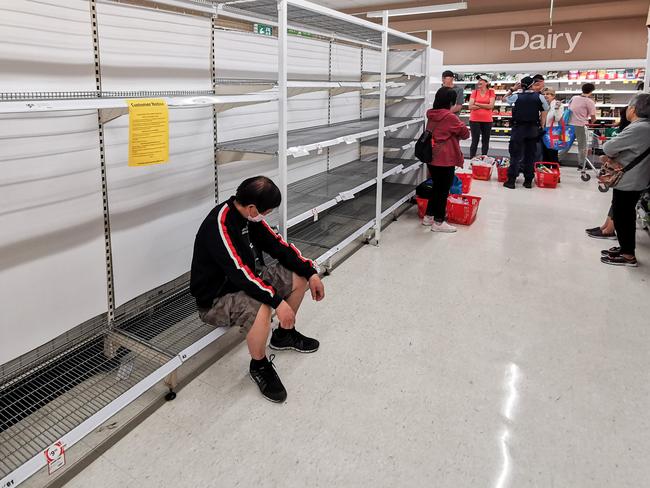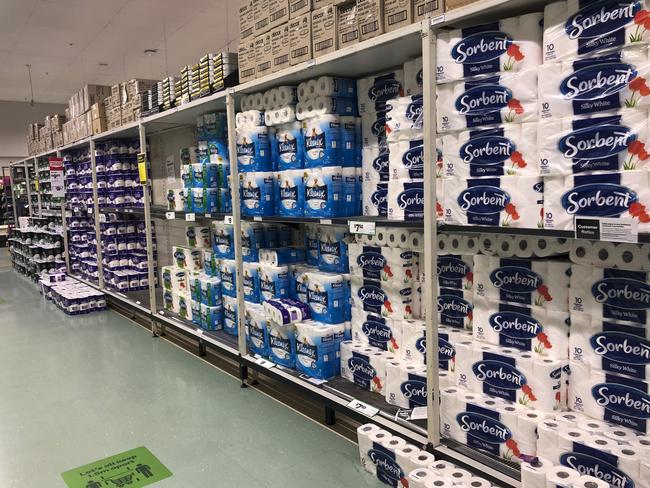Economists warn of long road to normality
Australians stuffed their homes with canned food, alcohol and gardening supplies in the days leading up to the COVID-19 lockdown. This comes as a new report spells out the road to recovery to get out of the expected recession.
Coronavirus
Don't miss out on the headlines from Coronavirus. Followed categories will be added to My News.
Australians stuffed their homes with groceries and DIY projects in anticipation of a coronavirus lockdown.
As the nation’s politicians look at how to reopen the economy, the latest retail data from the Australian Bureau of Statistics shows a record jump in food sales in March.
Spending in supermarkets went up 23 per cent with the strongest growth on non- perishables like flour, pasta, long-life milk and canned vegetables and soup. Liquor stores saw spending increase by more than 30 per cent for the month. Other strong spending spikes were in hardware, building and garden supplies (up 17.4 per cent), and electronic goods (up 11.3 per cent).
But the squeeze on discretionary spending as jobless queues grew and people’s hours were cut was also on display as spending on cafes, restaurants and takeaway fell a record 22.9 per cent.
Clothing, shoes and accessories spending dropped 22.6 per cent. BIS Oxford Economics’ chief economist Sarah Hunter says despite the hopes of politicians, it will be quite some time before retail trade returns to normal.

“The majority of the sector will not be able to operate as normal for many months, confidence is still well below historical averages, and some households will increasingly have to grapple with weaker incomes as a result of job losses,” she said on Wednesday.
Capital Economics’ Marcel Thieliant noted the record rises for groceries would be likely countered by a slump in spending in April.
Prime Minister Scott Morrison and state leaders are working toward a three-stage easing of coronavirus restrictions with the aim of having an open “COVID-safe” economy by the end of July.
The economy will take a $50 billion hit in the three months to June from the existing level of shutdowns, Treasury has estimated.
Treasurer Josh Frydenberg acknowledges it will take some sectors longer than others to return to normality.
“It’s a bit more difficult, as you say, in hospitality or in retail,” he told ABC TV.
“What we’re looking to do is to give confidence to the employers that they can get back into business because obviously they have to eat up what is left of their working capital in order to reopen and restock their cafe or their restaurant.

“(And) give consumers the confidence they can go and shop freely or eat freely at the restaurants and at the cafes.” Employers started to receive their first round of JobKeeper payments on Wednesday to help them pay and retain staff.
So far, more than 725,000 businesses have registered, covering 4.7 million employees.
That’s more than a million shy of the number of workers the government had anticipated it would cover, but Mr Frydenberg isn’t budging on expanding eligibility.
How much it comes in under the $130 billion price tag won’t be revealed until the delayed October budget.
Labor says the underspend on JobKeeper is a reflection of how hard it’s been for businesses and workers to access it.
“JobKeeper has the capacity to do a heap of good,” shadow treasurer Jim Chalmers told reporters.
“But the confusion around it, the poor communication, the fumbled implementation, the exemptions and exclusions form the JobKeeper payments mean that so many more Australians will join the unemployment queue … than is necessary.” The number of jobs in Australia dropped by 7.5 per cent in the month to mid- March and more than a million people have applied for unemployment benefits.
How Australian economy can bounce back after pandemic
A smorgasbord of small-scale works spread across Australia rather than a few big road and rail projects mainly in Sydney and Melbourne will be the best way to climb out of an expected deep recession.
That’s according to Deloitte’s latest quarterly Investment Monitor report released today.
The report shows a tiny improvement in the value of Australian investment projects, rising just 0.4 per cent since the December quarter to $768.9 billion, as COVID-19 began to shut down the economy.
“There will be a temptation for governments to pursue large nation-building projects as a way of stimulating the economy,” the report finds.
“But the focus should instead be on improvements to existing infrastructure and smaller developments.
“These types of investment tend to generate the largest economic returns, while smaller scale projects are also easier for contractors to commence quickly and to deliver on time and on budget.”
Such investment will be needed as the total amount of private business investment is set to fall by more than one-third in 2020.
The report anticipates a “deep recession” in 2020 with widespread job losses, a three-decade low in consumer confidence, and the largest decline in business confidence on record.
Treasury has predicted $50 billion will be wiped off the economy in the three months to June alone, saying every extra week the restrictions to contain the virus are in place costs another $4 billion in lost jobs, productivity and consumption.
The federal budget and state coffers are stretched but now is the time to consider innovative ways to finance and develop projects, says Deloitte Access Economics partner and report lead author Stephen Smith.
This could include removing barriers for private investment, improving the management of project risks, and using a wider range of funding sources, such as asset recycling.
In addition, methods such as user pricing could shift the burden away from taxpayers towards those who benefit directly from the new investment.
“These proposed reforms are not new but in responding to COVID-19, governments have a rare opportunity to make changes that help drive productivity and improvements to the living standards of Australians in the long-term,” Mr Smith writes.
Treasurer Josh Frydenberg has indicated he wants private industry, rather than governments, to be the main drivers of jobs during the recovery.
Despite the “heightened uncertainty”, the report strikes a positive note in expecting the most likely path forwards is “the virus will be contained and the economy will recover gradually”.
However, it warns: “The impact of COVID-19 on the Australian economy is expected to exceed any economic event since the Second World War.”
JOBKEEPER SPARKS MAYHEM AMONG AUSSIE WORKERS
Employers started to receive their first round of JobKeeper payments today to help them pay and retain staff.
Treasurer Josh Frydenberg continued to rule out another large round of economic stimulus and keeping the JobSeeker rate where it was beyond September.
“Our goal is to get those people off unemployment benefits and into a job and the best way we can do that is to generate economic activity,” Mr Frydenberg told ABC today.
News Corp found JobKeeper is pitting employer against employee and driving a wedge between colleagues as lack of clarity pushes businesses to opt out of the scheme and the one-size-fits-all payment creates inequality within teams.
Employsure managing director Edward Mallett said JobKeeper was “not as simple as it seems on the face of it”.
Some employers were choosing not to apply despite likely being eligible, creating tension with workers who could only receive the allowance if both they and their employer signed up.
“For an already-shutdown business with employees sitting at home – for example, a gym – JobKeeper asks (a business owner) to pay $1500 (per fortnight per eligible employee), where previously they weren’t obligated to pay anything,” Mr Mallett said.
“They are worried they are going to be left in the middle, paying out the money and not getting money back from the government.”

MORE NEWS:
Super funds warned on early access delays
Surprising COVID-19 pay cuts and job losses
Activities to keep the kids mindful throughout lockdown
Big battle facing sport, live events
Mr Mallett said this anxiety was the result of the Australian Taxation Office being unable to confirm a business’ eligibility for the government reimbursement until after they had already paid their staff then submitted their claim.
“I am seeing employers who might otherwise be eligible say, ‘I don’t want to get involved in this, there is too much unknown’,” he said.
Mr Mallett said JobKeeper was also “creating cultural problems” in businesses that were still operating but had signed up for the scheme as revenue had taken a hit.
Some full-time workers were suddenly earning the same as colleagues with much lighter workloads.
“Someone can be working full time earning about $1500 a fortnight, and someone can be working part time earning $200 a fortnight and suddenly both are earning the same amount,” he said.
Similarly, he said an employee on unpaid parental leave with zero earning expectation would suddenly be bumped up to $1500 a fortnight and someone on WorkCover and doing only limited shifts would earn JobKeeper on top of their WorkCover payment.
Mr Mallett said employees had to individually agree to be part of the scheme, even if their employer had signed up, but in doing so they signed away some of their rights.

This meant workers earning well above $1500 a fortnight faced a difficult decision.
“The employer can make unilateral decisions they did not previously have the power to do,” he said.
“They can stand you down and say ‘go sit at home – you were on $3000 a fortnight, now you are on $1500’.”
Although an employee in this situation could refuse to sign up to JobKeeper and continue working at the higher pay, he said they then risked being made redundant.
Stillwell Management Consultants head of organisational psychology consulting Alexandra Rosser urged business leaders to focus on transparent communication with staff during the pandemic.
She said they should highlight to staff that current pay levels were less about performance than about the preservation of the business and economy.
“There are a lot of people out there working the same hours as before, if not more, and they are the ones who might feel a sense of unfairness,” she said.
“Finding ways to express gratitude for that through means that go beyond pay is going to be crucial (for employers) at this time.”


